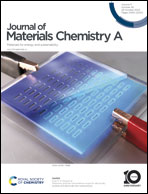1D transition-metal dichalcogenides/carbon core–shell composites for the hydrogen evolution reaction†
Abstract
2D transition metal dichalcogenides (TMDCs) have recently been proposed as an excellent catalytic substitute for noble metals in the hydrogen evolution reaction (HER). When assembled in a 1D nanotube configuration, TMDCs show enhanced performances originating from the curved lattice strain and nanosize. However, WS2 nanotubes (NTs) have minor electron mobility and low number of active edge sites, which hinder their effective use in electrocatalytic reactions. In this work, we present the synthesis of the core–shell structure of WS2 NTs coated with carbon. WS2 NTs were coated with nitrogen-doped graphitic carbon in three steps. After physical adsorption and annealing, excessive carbon was removed by CO2 gas, which acts as a mild oxidizer. Finally, recrystallization of the carbon coating at 800 °C was done by thermal annealing in the presence of N2. Products after each reaction step were chemically analyzed. Following the recrystallization, the heterostructure WS2 nanotubes/carbon showed significantly improved HER performance, exhibiting an overpotential of 172 mV compared to 540 mV for the uncoated NTs. The improved activity was confirmed in different pH electrolytes. Moreover, the carbon coating significantly improved the electrochemical stability of the WS2 by protecting it upon prolonged reductive operation. The formation of carbon-coated WS2 NTs composite material provides a promising way to obtain a pH-universal, cost-effective electrocatalyst for energy conversion.

- This article is part of the themed collection: #MyFirstJMCA


 Please wait while we load your content...
Please wait while we load your content...